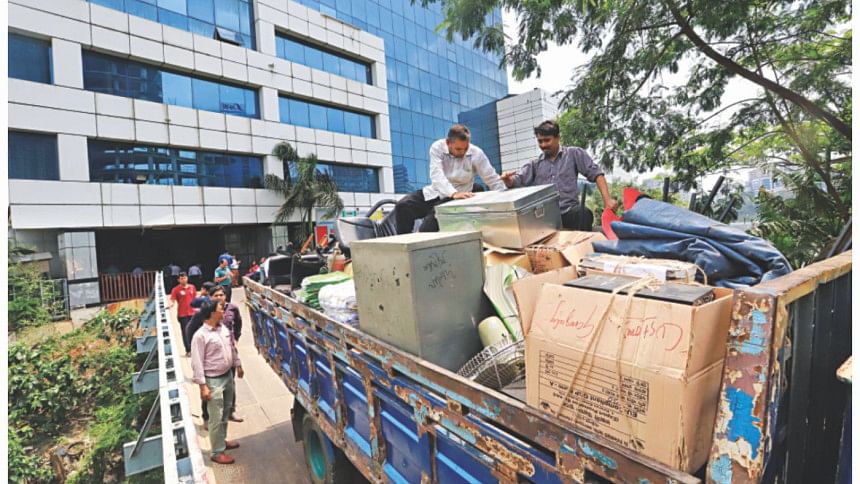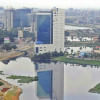Demolition or drama?

After an eight-and-a-half year legal battle culminating in a victory for Rajuk, the capital development officials yesterday went to demolish the illegal 15-storey BGMEA building in a move which lacked coordination and was mired in confusion.
Officials spent the day evicting those in the Bangladesh Garment Manufacturers and Exporters Association (BGMEA) building, which is situated in the middle of Begunbari canal and Hatirjheel wetland.
The High Court, however, had earlier given the building owners three chances to vacate the building.
The last chance allowed them time until 12 April -- after which the building was supposed to be demolished -- but even that was not heeded to.
By 8:00am in the morning yesterday, officials of Rajdhani Unnyan Kartripakkha (Rajuk), led by its zonal director Khandaker Oliur Rahman, had mobilised heavy equipment like bulldozers, excavators and loaders in front of the building in Karwan Bazar.
Four platoons of police took position in front of the building and barred access to it to anyone except Rajuk officials.
A couple of hours went by. But nothing happened.
Although equipped with such heavy demolition machineries, the Rajuk team appeared unsure of how to go about the mammoth task of pulling down the gigantic structure.
Despite the HC deadline having already passed, Rajuk officials yesterday allowed the occupants seven hours until 5:00pm to take their belongings.
By 5:00pm, Rajuk officials sealed the building and left.
Continuing to occupy the building after expiry of the deadline is a violation of the court order, said Syeda Rizwana Hasan, chief executive of Bangladesh Environmental Lawyers Association, which conducted the case as amicus curie.
NO ONE HAS ANSWERS
Scores of television and print journalists, who had gathered to cover the event, wanted to know from the officials how and when the demolishing would start.
These questions led to another round of confusion among the officials.
Khandaker Oliur Rahman reacted angrily as to why the reporters were speaking to Rajuk Executive Magistrate Jesmin Akhtar, since she was “not authorised” to talk to the media.
The media personnel then requested Oliur to explain what was going on. He first said Rajuk Chairman Md Abdur Rahman would come to the scene and talk to the media.
Afterwards, he backtracked and said the chairman was busy and would not turn up.
Then at 12:00pm, he said there were some preparations needed before the demolition could begin, for example, disconnecting electricity and water lines.
“There are still occupants in the building with their belongings. There are some vaults of banks. We have to first empty the building of possessions and [then] go for demolition,” said Rahman.
Asked whether they had not made sure the building was vacated before coming to demolish it, Oliur said, “Reality is something different. We have to consider it.”

While Oliur was answering questions, Rajuk chief engineer ASM Raihanul Ferdous suddenly appeared in the scene and opposed Oliur's actions.
“You cannot talk to the media,” Ferdous told Oliur.
“Of course I can. I am the director and magistrate in charge of today's demolition work,” Oliur replied.
He then went back to answering queries.
“Once vacated, we will disconnect electricity supply to the building and keep all the floors locked-up,” said Oliur.
Asked when they would demolish the building, Oliur said, “I don't know exactly…it will take time.”
Asked why they had mobilised heavy equipment if they had not intended to demolish the building yesterday, he said, “I will talk to you in this regard later.”
Outgoing BGMEA President Siddiqur Rahman could not be reached for comments despite repeated attempts by this newspaper.
The then Prime Minister Sheikh Hasina laid the foundation stone of the building on 28 November 1998.
Later on 8 October 2006, the then Prime Minister Khaleda Zia inaugurated the 15-storey BGMEA building.
Afterwards, the highest court found that the building was constructed illegally.
Following a news report on October 3 in 2010, an HC bench issued a suo-moto rule on the authorities as to why the building should not be demolished.
On April 3 2011, an HC bench ordered the demolition of the illegal building but two days later the Appellate Division stayed the verdict for six weeks and asked BGMEA to file a leave to appeal against the verdict.
On 19 March 2013, the HC in its verdict ordered the relevant authorities to demolish the much-discussed about illegal building in three months.
The court, in the verdict, directed BGMEA to refund money to the buyers of floor space in the 15-storey building within a year.
In April last year, the appellate bench of the Supreme Court ordered the BGMEA building be demolished after April 12 this year.
The court termed the building “a cancer in the Hatirjheel project,” as it blocked water flow between Hatirjheel lake and Begunbari canal.

 For all latest news, follow The Daily Star's Google News channel.
For all latest news, follow The Daily Star's Google News channel. 







Comments